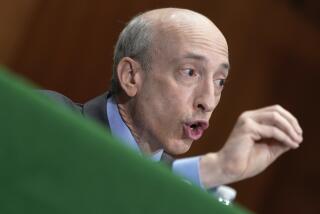SEC Rule Would Put Price Over Speed in Trades
WASHINGTON — Federal regulators proposed a new rule Wednesday that would rank price over speed in buying and selling stocks.
The Securities and Exchange Commission submitted the proposal to a 30-day public comment period.
The commission had planned to vote on the proposal Wednesday as part of a broad package of stock trading rules but decided instead to “go beyond our statutory obligations and give all interested parties” time to review it, SEC Chairman William H. Donaldson said.
An investor’s right to the best stock price available is a long-standing doctrine in securities markets, applying to sellers who seek the highest price and buyers who seek the lowest.
Earlier this year, the SEC staff suggested giving traders the option of rejecting the best price if their clients preferred a fast deal.
Nasdaq and other automated exchanges pushed for that change.
They can execute trades many times faster than the New York Stock Exchange and the NYSE auction system, which relies on floor traders linking buyers and sellers.
Some institutional investors supported the revision, saying that by the time the NYSE gets around to executing a trade for a large number of shares, the “best price” may have disappeared.
The NYSE, which uses best-price as one of its strongest selling points, fought the change. In a victory for the Big Board, the SEC staff decided to rewrite the proposal.
Under the latest plan, the rule requiring brokers to get the best price would apply to all stock markets and nearly all types of trading orders, assuming they could be filled electronically.
In addition, brokers would be required to “sweep” all the markets to find the best price.
On Wednesday, Donaldson said the new best-price rule was intended to ensure that stock traders didn’t put their interests ahead of stock investors’.
Sometimes, for traders, “it may be faster to trade with another order at a worse price. Or the trader may be selling a large number of shares at a price below the best quote and not want to bother trading with a relatively small displayed quote,” Donaldson said.
Not all of his colleagues were convinced.
“I have tried unsuccessfully to identify the problem that the commission is hoping to solve with this complicated experiment,” said Commissioner Paul S. Atkins.
Cynthia A. Glassman also expressed concerns, although she voted to put the proposal to public comment. Noting that it was the SEC’s second attempt at forging a new best-price rule, she cautioned: “We may even need Round 3 to get to the right result.”
The best-price rule was one part of a broader proposal designed to modernize the SEC’s stock market rules, addressing technical issues of pricing, data formulas and non-discriminatory access by traders to the various exchanges.
Some of these provisions could pose a challenge to the NYSE and its floor trading system.
Commissioner Harvey J. Goldschmid said the U.S. stock market was a national “gem” but that certain aspects were antiquated.
“We need to modernize” to bring rules created for a floor-based system of trades up to date, he said.
Times staff writer Walter Hamilton contributed to this report, and Associated Press was used in compiling it.
More to Read
Inside the business of entertainment
The Wide Shot brings you news, analysis and insights on everything from streaming wars to production — and what it all means for the future.
You may occasionally receive promotional content from the Los Angeles Times.










